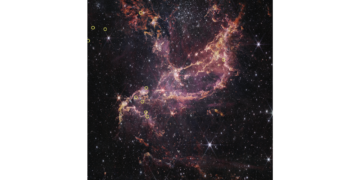The James Webb Space Telescope (JWST) has once again amazed scientists with groundbreaking findings that challenge long-held beliefs about how planets form. Recent observations reveal that planet-forming disks around stars in the early universe lived far longer than previously thought.
Why Is This Discovery So Important?
Planetary systems have always fascinated astronomers. For decades, scientists believed that heavy elements like carbon and iron—created through supernova explosions—were necessary for planet formation. In the early universe, stars primarily consisted of hydrogen and helium, with very little of these heavier building blocks. Consequently, the lifespans of planet-forming disks around young stars were predicted to be short-lived, lasting no more than 2–3 million years.However, recent findings by NASA’s JWST challenge this theory.
By studying NGC 346, a star cluster in the Small Magellanic Cloud (a nearby galaxy with fewer heavy elements), Webb confirmed that planet-forming disks can survive for 20–30 million years—ten times longer than expected.
The Early Universe and the Mystery of Heavy Elements
The universe, in its infancy, was a vastly different place. Stars born shortly after the Big Bang were primarily composed of hydrogen and helium, lacking the heavier elements—known as “metals” in astrophysics—that play a key role in planet formation today. Astronomers use the term metallicity to describe the abundance of these heavier elements in a star.
Low-metallicity stars, such as those in the Small Magellanic Cloud, were believed to have weak disks that quickly dissipated due to stellar winds and radiation pressure. Without these disks, there would be no raw material to form planets.This is why Hubble’s 2003 discovery of a massive planet orbiting an ancient, metal-poor star was so puzzling.
How could such a planet exist if the conditions for its formation were seemingly impossible? Hubble hinted at an answer in the mid-2000s when it observed planet-forming disks around 20–30-million-year-old stars in the star-forming cluster NGC 346. But without detailed spectral data, the finding remained controversial. Scientists needed solid proof to confirm whether these disks were genuine or simply observational anomalies.
How Webb Solved a Two-Decade-Old Mystery
Enter the James Webb Space Telescope, the most powerful space observatory ever built. Webb’s superior sensitivity and resolution allowed scientists to revisit NGC 346 and provide concrete evidence of planet-forming disks around low-metallicity stars.
Webb observed ten Sun-like stars in NGC 346, capturing detailed spectra of their surroundings. These spectra revealed clear signs of accretion, the process by which material from a disk feeds onto a growing star.
This confirmed that the disks were actively supplying material, and were not simply remnants of past stellar activity.“With Webb, we have a really strong confirmation of what we saw with Hubble, and we must rethink how we model planet formation and early evolution in the young universe,” said Guido De Marchi, the study’s lead scientist from the European Space Research and Technology Centre.
Why Do These Planet-Forming Disks Last So Long?
One of the most surprising aspects of Webb’s discovery is the longevity of these disks. In environments with low heavy elements, traditional models predicted that radiation pressure from the host star would quickly blow away the disk material.
Scientists propose two possible explanations:
1. Weaker Radiation Pressure: Without many heavy elements in the gas, the radiation pressure that disperses disks may be less effective.
.2. Larger Initial Gas Clouds: Low-metallicity stars may form from much larger gas clouds. These larger disks contain more material and take longer to be dispersed, even under radiation pressure.Both scenarios are exciting because they challenge current models of star and planet formation. If these disks last longer, it means planetary systems in the early universe had more time to evolve, grow, and potentially develop complex architectures similar to our solar system.
Webb’s Unique Capabilities and the Future of Planet Formation Research
The James Webb Space Telescope continues to revolutionize exoplanet research. Its ability to capture high-resolution images and detailed spectra gives scientists unprecedented tools to study planet formation in diverse environments.
Webb’s confirmation of long-lived disks in NGC 346 demonstrates its ability to solve longstanding mysteries and challenge existing theories. This finding marks just the beginning of a new era in planet formation studies.
Looking ahead, Webb will continue to explore other low-metallicity regions and provide insights into the mechanisms that allow disks to survive in such environments.
Advanced 3D modeling will further refine our understanding of disk dynamics and the conditions necessary for planet formation.“This has implications for how you form a planet, and the type of system architecture that you can have in these different environments. “This is so exciting,” said Elena Sabbi, co-investigator of the Webb study.
Conclusion: A New Chapter in Our Cosmic Story
The James Webb Space Telescope’s discovery of long-lived planet-forming disks in NGC 346 is rewriting what we thought we knew about planetary evolution. By confirming that these disks persist for tens of millions of years in environments lacking heavy elements, Webb has solved a decades-old mystery and forced scientists to rethink the building blocks of planet formation.



















